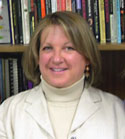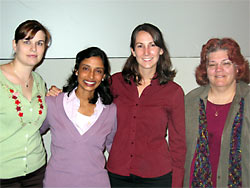
An electronic newsletter for the science education
community
Field Notes
Educators share how they are using Project 2061 tools
This 2061 Connections report is the first in a series in which educators share—in their own words—how they are using AAAS Project 2061 reform tools to improve science and mathematics education. Gathered for this issue are the voices of a science education professor from Missouri, a science program director from Maine, and four high school chemistry instructors from New York. These educators explain how Science for All Americans, Benchmarks for Science Literacy, and other Project 2061 tools promote a deeper understanding of science content standards and facilitate such tasks as teacher education, teacher mentoring, and curriculum design.
Using Project 2061 Publications in Science Methods
Courses
Maryville University School of Education is a small teacher
education program accredited by the National Council for
Accreditation of Teacher Education and nationally recognized
for excellence. The School of Education offers undergraduate
study in early childhood, elementary, and middle school
certification and a master’s degree in education.
Certification and master’s degree specialization is
also offered in early childhood, secondary teaching and
inquiry, elementary, middle, and K–12 art. Project
2061 publications are used extensively in the elementary/middle
and secondary science methods courses and have been the
focus of recent master’s projects.
Elementary education candidates use Benchmarks for Science Literacy to identify “big ideas” toward which their instruction is moving. In addition, they use the Benchmarks research base and excerpts from Science for All Americans to identify likely student thinking and misconceptions prior to teaching. Following instruction, candidates analyze student thinking observed during the lesson or represented in student work in light of the same information. Candidates who concentrate in science at the elementary and middle levels are further required to use Science for All Americans to broaden the connections they make when teaching. Finally, all degree candidates are introduced to the concept of scientific literacy as an appropriate goal for science education in a democracy. Benchmarks for Science Literacy, supplemented by Science for All Americans, is used to convey Project 2061’s vision that all children gain the knowledge, skills, and attitudes that enable responsible citizenship.
The secondary science methods course is team taught by a high school science teacher, a chemistry professor (from the School of Arts and Sciences), and myself—a science education specialist. The collaborative structure is gradually influencing work in university and high school science courses, in addition to our work in secondary methods.
Secondary degree candidates use Science for All Americans, Benchmarks, and portions of Designs for Science Literacy to frame personal teaching philosophies, anchor lessons in “big ideas,” and identify likely misconceptions or errors in student reasoning. Project 2061 materials help secondary degree candidates reflect critically on what they observe in most high school classrooms, and offer a catalyst for debate among all of us about necessary concepts to include in core courses.
Dr. Ball is an Associate Professor of Science Education at the Maryville University School of Education in St. Louis, Missouri.

- Page Keeley
Helping New Teachers Help Themselves
The Northern New England CoMentoring Network (NNECN), a
National Science Foundation-funded "leadership through
content-focused mentoring” program, is introducing
300 mentor and novice science and mathematics teachers
to Project 2061 tools. We use Science for All Americans, Benchmarks
for Science Literacy, and Atlas
of Science Literacy to help the teachers build
a common knowledge base about learning goals and effective
instruction.
In working with teachers from Maine, New Hampshire, and Vermont, we meet a significant challenge as mentors operate from three different sets of state standards and varied curriculum programs. The Project 2061 tools give us a common set of ideas to focus on as a group. Our mentors learn how to examine a benchmark for its key ideas, examine the benchmark’s relationship to other benchmarks, and consider implications for instruction, including being aware of possible misconceptions their students might hold that would impact their teaching. Equipped with these powerful tools and a process for using them, the NNECN mentors and their novice teachers engage in learning-focused dialogue about teaching science or mathematics ideas deemed important for literacy. In the process, new teachers strengthen their own understanding of content, identify best ways to make the ideas accessible to their students, and build a deeper understanding of their own state standards through the lens of the benchmark ideas.
The use of Project 2061 tools, so deeply embedded in our approach to supporting new teachers, distinguishes our approach from other mentoring and induction programs that emphasize survival skills, general pedagogy, and superficially address standards. As one first year teacher commented, "I can't imagine being a new teacher without these resources to support me. Now when I have questions about teaching a concept and no one is available to help me, I can help myself."
Page Keeley is the Principal Investigator of the NNECN and a Senior Science Program Director for the Maine Mathematics and Science Alliance.
Redesigning a Chemistry Curriculum in New York
As a team of four chemistry teachers recently tasked with
rewriting the chemistry curriculum at Hilton High School
in Rochester, New York, we found Benchmarks for Science
Literacy to be a valuable guiding framework.

- From left to right:
Kerry Fein, Alpa Khandhar, Sarah Hurley, Trudy Murphy
With the constraints of mandated curricula and standardized tests and the frustrations they are bringing to classrooms, teachers, and students, rewriting our curriculum was a pressing concern. Like other educators, we struggled to balance the needs of standardized tests without losing the greater context and relevance of what is being taught. While these goals should not be mutually exclusive, many times they seem as though they are. When a dusty copy of Benchmarks was discovered by our group, it was an "aha" moment, as we realized that this document we had used back in graduate school could really help us to find the balance we were seeking. It helped us to redefine our end and to look past the “test,” focusing instead on creating scientifically literate citizens. We loved Benchmarks in graduate school, but now we had the experience to really understand how to use it.
Our team rewrote the curriculum with a science literacy focus and found areas where Project 2061’s benchmarks overlapped with concepts in our state standards that we considered essential to lasting knowledge in chemistry. We also identified learning goals for each unit according to both the New York Regents standards and our literacy standards. Finally, we created choices for how students could demonstrate their achievement of the literacy standards using a variety of assessments. We will pilot the new curriculum this school year and likely struggle with assessment. But most importantly, while we still intend to teach the course using the state standards, our literacy standards will inform our decisions about which concepts and skills are more or less worthy of our time.
Ours is definitely a work in progress, but in the world of mandated curricula and standardized tests, we view the new curriculum as liberating. Within the given constraints, choosing where we focus our time and our students' efforts based on sound choices—using Benchmarks as a guide—is a way of exerting our authority and expertise in science and education.
—Kerry Fein, Sarah Hurley, Alpa Khandhar, and Trudy Murphy
Hilton High School, New York



